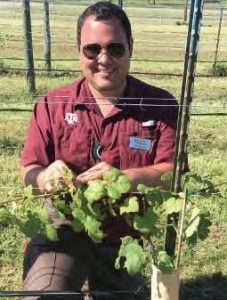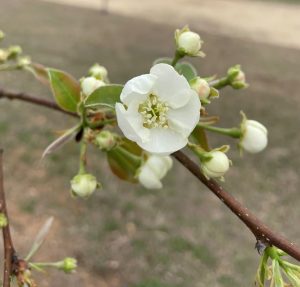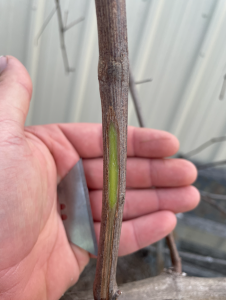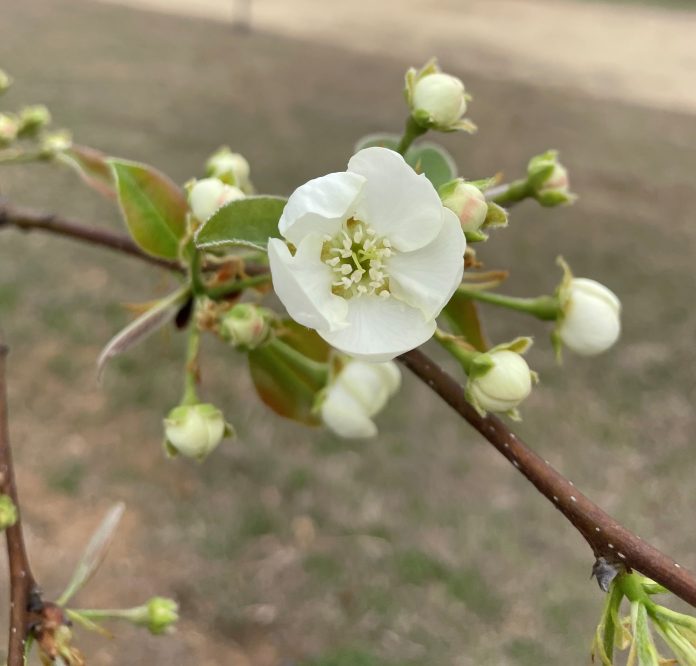
By Michael Cook, North Texas Wine Grape Specialist, Texas A&M AgriLife Extension – Denton County
The phrase “patience is a virtue” has certainly shown relevancy for gardeners in North Texas this season following the blanket of extreme cold that winter storm Uri provided.
Many of us have had the pit of uncertainty forming in our stomachs since mid-February as we await and see what is in store for not only our fruit harvest this year but also whether or not our fruit trees, shrubs, and vines are going to even survive the season.
Now that daytime temperatures are consistently in the mid to upper 70s, soil temperatures are beginning to creep up to normal springtime levels. This means that in Denton County our fruiting plants are now starting to show signs of either life or death. So where do we go from here?
For starters, shortly following the winter storm you probably noticed a few things when you assessed your orchard or vineyard. Hopefully you checked the shoots, trunks, and main branches by looking at the wood and also gently scratching the bark. If you observed splits or cracks in the permanent structures of your plant such as the trunk, the plant sustained significant damage and will most likely need to be replaced, unless you can retrain from growth from below the injured tissue. When scratching the bark, if you saw bright green, there is a good chance your plant will be ok. Hopefully you are seeing new growth pushing from this wood. If the wood is brown, that part of the plant is dead and chances are less optimistic the tree itself is going to make it unless you are seeing other limbs that are green. Now that we are in spring, go ahead and re-assess your plants. Another sign that you may have witnessed or are observing right now is the status of the leaves. Under most circumstances if the leaves turn brown and fall off the shoot naturally there is a good chance the shoot itself is still alive and should be budding out or will be very shortly. If dead leaves remain attached to the shoot there is a high probability the shoot is dead. Again, if your plant has the ability to send out suckers from the ground you may be able to retrain the plant, but more on that in a little while.
 Many of our fruit trees have shown some signs of injury, some minor and some devastating. Fortunately, most of our fruit trees such as pear, pecan, apple, persimmon and even grapes and blackberries were all very much dormant when the storm hit and are just fine. They are now starting to flower and/or push new foliage. Certain peach and plum cultivars, in particular “low-chill” varieties, are showing more shoot dieback and even crop loss. Any flowers that were in full bloom at the time of the winter storm would have been frozen. This is why we generally do not recommend growing “low-chill” fruit varieties in our region, even under more normal years, the risk for crop loss is too great. But if you are seeing flowers on your fruiting plant right now this means you should have at least a partial crop this year. For all crops, you can go ahead and trim back any twig dieback or damaged tissue. If a main scaffold branch on your tree is showing no signs of life and fails the bark scratch test you can leave it for a little while longer but will most likely have to remove it. Hopefully there is a new green shoot that is nearby that can be used to replace the dead scaffold. Olives, avocados, and citrus, which are much more cold sensitive are not faring well and will most likely need to be replaced.
Many of our fruit trees have shown some signs of injury, some minor and some devastating. Fortunately, most of our fruit trees such as pear, pecan, apple, persimmon and even grapes and blackberries were all very much dormant when the storm hit and are just fine. They are now starting to flower and/or push new foliage. Certain peach and plum cultivars, in particular “low-chill” varieties, are showing more shoot dieback and even crop loss. Any flowers that were in full bloom at the time of the winter storm would have been frozen. This is why we generally do not recommend growing “low-chill” fruit varieties in our region, even under more normal years, the risk for crop loss is too great. But if you are seeing flowers on your fruiting plant right now this means you should have at least a partial crop this year. For all crops, you can go ahead and trim back any twig dieback or damaged tissue. If a main scaffold branch on your tree is showing no signs of life and fails the bark scratch test you can leave it for a little while longer but will most likely have to remove it. Hopefully there is a new green shoot that is nearby that can be used to replace the dead scaffold. Olives, avocados, and citrus, which are much more cold sensitive are not faring well and will most likely need to be replaced.
 Moving on, let’s talk a little more about retraining fruiting plants. If you are seeing lots of suckers either coming from below ground or forming along the bottom part of the trunk this tells us the tree most likely has suffered severe damage farther up in the canopy and is responding by trying to push out new growth from where it is alive; the base. Now, if you planted a fruit tree that is what we call “own-rooted” you can easily retrain the tree by selecting the best-looking shoot(s) while removing any that are not necessary. Most if not all of our pomegranates, figs, blueberries, olives, and blackberries are own-rooted and can be retrained if the canopy is dead or weak from these suckers that arise. Note, if a plant has sustained heavy damage to the canopy it may take a few more weeks for suckers to arise, continue to be patient. If by that time they do not the plant is most likely gone.
Moving on, let’s talk a little more about retraining fruiting plants. If you are seeing lots of suckers either coming from below ground or forming along the bottom part of the trunk this tells us the tree most likely has suffered severe damage farther up in the canopy and is responding by trying to push out new growth from where it is alive; the base. Now, if you planted a fruit tree that is what we call “own-rooted” you can easily retrain the tree by selecting the best-looking shoot(s) while removing any that are not necessary. Most if not all of our pomegranates, figs, blueberries, olives, and blackberries are own-rooted and can be retrained if the canopy is dead or weak from these suckers that arise. Note, if a plant has sustained heavy damage to the canopy it may take a few more weeks for suckers to arise, continue to be patient. If by that time they do not the plant is most likely gone.
On the other hand, many of our fruit trees, such as peaches, pecans, apples, pears, plums, persimmons, jujubes, citrus, and even some grapevines cannot typically be trained from suckers because they are what we call grafted (or budded) plants. Under normal circumstances this is a good thing as a rootstock helps our fruiting plants tolerate certain soil and environmental conditions better that if it was own-rooted. The one drawback to this is when we get too cold and we lose the top part (the scion, or fruiting variety) and are stuck with just the rootstock. The rootstock, which is often very hardy, will push out suckers and attempt to grow. With just rootstock remaining there is no point in retraining a tree unless you are a skilled grafter and have have access to scionwood.
With some plants, such as citrus grafted unto trifoliate orange rootstock, it can be easy to identify rootstock suckers as they are very vigorous, thorny, and have small dark green leaves. With other plants you will have to look for the graft union, or fusing point where rootstock and scion meet. This is often seen as a knot like bulge on the trunk a few inches from the soil surface. Suckers below the graft union are rootstock and should be removed while suckers coming out above the union are scion material and can be used to retrain the plant. So before you attempt to retrain an injured plant, make sure you know whether or not it is own-rooted or grafted.
Also, just because we had a winter storm does not mean we should not go ahead and prune our fruit plants as normal. Unless you are retraining the tree completely or have good reason otherwise, usual pruning still needs to be done. Additionally, with all fruit crops we need to be very selective with adding fertilizer this season, more is not better. Only provide what the plant needs. If necessary, submit a soil sample to www.soiltesting.tamu.edu. Also, if nitrogen is needed, apply it in early to mid-April instead of mid-March, which is customary. Furthermore, ensure your plants are being watered appropriately, do not let them dry out but also do not overwater. Similar to fertilizer, excessive watering will not help your fruit plants but will only compound the problem.
It does appears that we have lost some of our more cold susceptible fruit crops thanks to winter storm Uri but others have fared well. Now that spring is here, we can begin to move forward. Make sure to visit www.aggie-horticulture.tamu.edu for more information on fruit tree, shrub, and vine management. We are here to help!
Texas A&M AgriLife Extension provides equal opportunities in its programs and employment to all persons, regardless of race, color, sex, religion, national origin, disability, age, genetic information, veteran status, sexual orientation, or gender identity. The Texas A&M University System, U.S. Department of Agriculture, and the County Commissioners Courts of Texas Cooperating













 GIF.gif)


